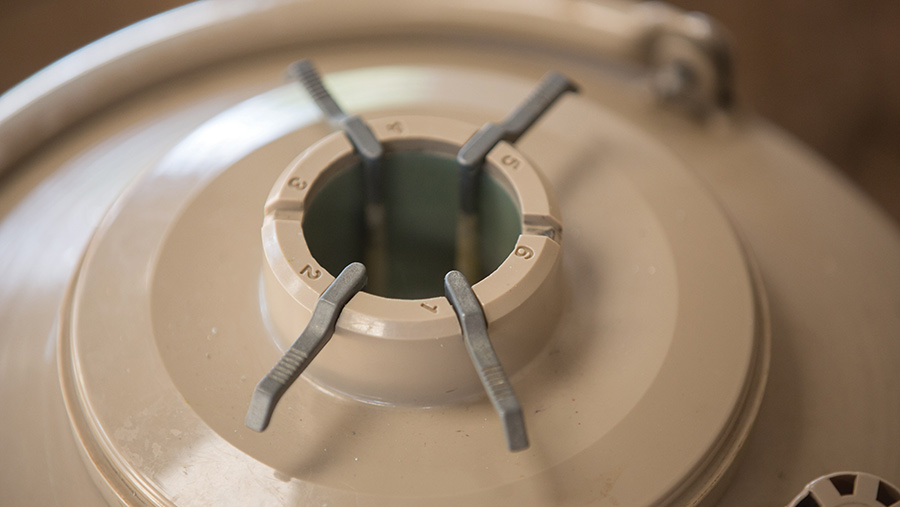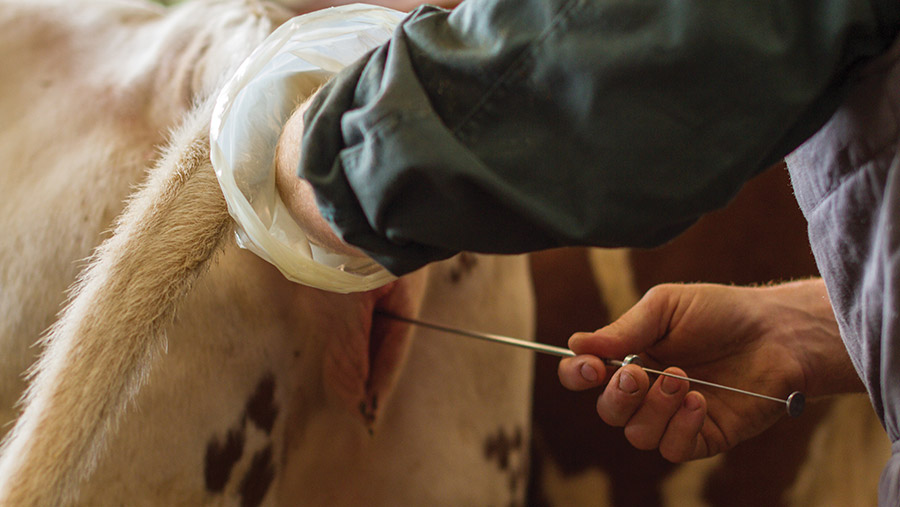Tips for ensuring cattle semen is stored safely and cleanly
 © Tim Scrivener
© Tim Scrivener How clean is the farm’s semen flask? Artificial insemination (AI) training, a starter pack including flask, guns and gloves, and a liquid nitrogen contract will fail to generate a return on investment through herd genetic improvement if fertility rates fall because semen has been stored in suboptimal conditions.
Farm semen flasks should be sited in a clean and dry, well-lit area with good access, says Cogent UK fertility specialist Tom Sellers.
This complies with the law requiring flasks to be in a lockable container and not readily accessible to the public. It also protects a valuable asset.
“Semen is a very fragile product: everything kills it except vaginal mucus and non-spermicidal lubricant.
“This is why it is important to minimise the chance of contamination from muck, dust, or vermin when removing straws and using AI equipment,” he explains.
Semen value
Tom points out that a typical semen tank contains six goblets, each holding 200 frozen straws.
“Even if it is all beef semen, that is 1,200 straws worth £7,000. If half of them are sexed straws – value £18,000 – that is £21,500 stored in the flask. It is a lot of money, [so] why wouldn’t you want to look after it?”
Flasks are sold with a lockable container (wood or plastic) designed for protection, as well as hygienic storage.
This container and its contents need to be kept away from damp, extremes of temperature, chemicals and slurry, yet ideally, be sited as close as possible to cows.
“The shorter the distance, the better. You need to get semen into the cow within five minutes of thawing it and don’t want to use up that time walking to the cow,” says Tom.

© Guillaume H/Adobe Stock
Ventilation
Most modern dairy units create space in a farm office (or other room) beside the dairy and close to handling facilities. This also allows easy access for straw deliveries and top-ups of liquid nitrogen.
However, Tom points out that tanks must also be stored in a well-ventilated area. Liquid nitrogen boils at -195C and as soon as it is exposed to the atmosphere, it vaporises.
Without ventilation, he says that anyone exposed to the fumes would suffocate.
“Nitrogen is odourless and colourless, and you can’t detect it escaping, so you have to monitor its volume to identify problems,” he adds.
Monthly (preferably weekly) flask dipstick checks are, therefore, important. Tom advises not relying only on the contract topping up nitrogen every six to eight weeks: “Put it in your phone as a reminder,” he says.
Liquid nitrogen levels
Low levels can be caused by the flask bung being left off and nitrogen evaporating, or if the flask splits and leaks.
Checking the dipstick ticket after every top-up will highlight a problem: a pre-fill reading will be consistently at 20-25cm, but this can fall when the flask is frequently opened, says Tom.
“This happens when you are serving more, so are in and out of the flask, such as in a block-calving herd over six to eight weeks.
“If nitrogen is below 15cm, it is worth a phone call to request a top-up; below 10cm is a cause for concern.”
Besides good storage, on-farm AI needs a clean, dry preparation table to hold the water bath, lubricant and other necessary kit.
The aim is to get everything ready at the flask, without fumbling and dropping a straw:
“This is why the whole area needs to be well-lit, clean and dry with good access. All you should take to the cow is a loaded gun, paper towel, plastic sheath and a glove.”
Water bath care
Another reason to have suitable flask-side facilities is to set up the water bath for thawing straws. It should always be left on, not switched on and off like a kettle, says Tom.
“It will use more electricity by restarting it, even if only once a week. It is designed to warm up and keep water at a consistent temperature.
“A block-calving herd can switch on at the start of mating, then off at the finish, while an all-year-round calving herd needs to leave it on.”
Water in the water bath should be changed weekly to avoid bacterial contamination – and the temperature checked each time it is used:
“Don’t rely on the temperature gauge – use a thermometer, or the colour change card that comes with the bath,” he says.
A flask for each site
Semen flasks are designed for storage, not transportation between farms.
“This will slosh the liquid around and can dislodge straws which then sink to the bottom. If a tank is dropped, its inner layers might split and leak, showing as frost on the outside.
“The cost of a new flask won’t break the bank, so if you have two units, have two flasks. If you have a block service period, you can hire or loan a flask.”
Tanks more than 10 years old cannot be insured. Tom says contents are only covered when a flask leaks, cracks or is damaged. If this happens, it is best to buy a new one.
A lost or damaged tank bung should always be replaced – Tom has seen old socks used on farm to plug the hole, but says a bung is insulated to maintain the correct flask temperature.
